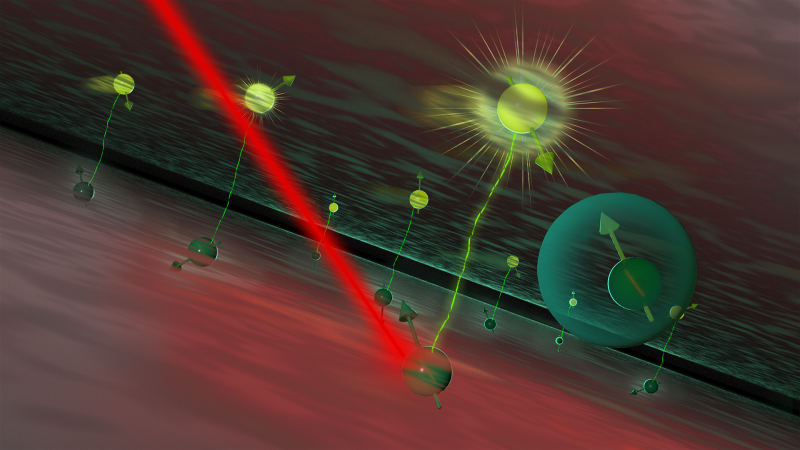A recent discovery by researchers at Northern Illinois University and the US Department of Energy’s (DOE) Argonne National Laboratory revealed that light could be used to determine the spin state of a class of materials known as perovskites (in this case, methylammonium lead iodide, or MAPbI3). This discovery was published in Nature Communications.
 Illustration showing exciton formation in a new semiconducting material used for quantum sensing. Image Credit: Ellen Weiss/Argonne National Laboratory.
Illustration showing exciton formation in a new semiconducting material used for quantum sensing. Image Credit: Ellen Weiss/Argonne National Laboratory.
Perovskites, a class of materials with unique electronic bonding and a wide range of applications, could be helpful for quantum sensing.
Numerous researchers are investigating various materials for possible applications in quantum technology. Spin is a crucial characteristic of the atoms in these materials. Spintronics, the goal of which is to manipulate atomic spins to create new kinds of materials, could be applied to cutting-edge technologies like quantum sensors for incredibly accurate measurements and memory devices.
Perovskites have numerous potential applications, ranging from solar panels to quantum technology.
To comprehend spin, consider the orbiting electrons of the atomic nucleus. Atoms near one another could exchange some of their outer electrons, forming a bond. Two electrons are “paired” in each bond, which means they share an orbital, or the area in which they travel.
Now, each of these paired electrons can have one of two spin states: up or down. If one electron spins upward, the other spins downward. Since it is not possible to tell which electron has which spin without looking at it, it is called being in a quantum superposition — a state in which they both spin up and spin down until observed.
This is the same concept as in quantum computing. A quantum bit, or qubit, can represent both zero and one at the same time, whereas a classical bit can only be one or the other. In some ways, quantum computers outperform traditional computers.
Identifying and controlling electron spins is essential for creating quantum devices such as computers and sensors.
One of the two paired electrons in the perovskite material was excited by light in the study. A “hole” was left in the lower-energy level as a result of the electron moving to a higher-energy level. An exciton is this combination of one excited electron and one hole.
When light energy is transformed into electric potential energy, excitons are created. Excitons typically don't last long because light is released when the excited electron eventually returns to the hole through a process known as recombination. These excitons typically have a short half-life of a few tens of nanoseconds in MAPbI3.
The research team, headed by Professor Tao Xu of Northern Illinois University, found a method to increase the exciton's lifetime by over ten times. Neodymium, a rare earth metal, was added to the material to achieve this. The outer orbital of neodymium contains unpaired electrons, which makes it a good candidate to interact with the electrons of the exciton.
A neodymium atom’s orbital is partially occupied by an electron that is promoted to a higher orbital in the exciton. As a result, the neodymium atom's localized spins form a spin-entangled state. The neodymium’s entangled electron remains attached to its perovskite partner electron.
Despite being separated, they are still able to “communicate” with one another, which could be utilized for quantum sensing and provides scientists with valuable information about the material.
We can use neodymium to act as a probe to observe the spins in the exciton.
Saw Wai Hla, Study Co-Author and Physicist, Argonne National Laboratory
Argonne Nanoscientist Benjamin Diroll, another co-author, added, “The main point is that we can communicate with the individual electrons in an exciton through their interactions with the neodymium atoms. This is exciting because, normally, these electrons just decay and release light.”
Xu claims that under a relatively low magnetic field, neodymium functions as a quantum sensor. However, the neodymium’s spins become locked and the connection to the exciton breaks down if the magnetic field is too strong.
The exciting part is that by adjusting the neodymium concentration, we can detect the spins of excitons. This could potentially allow us to entangle up to 10 electron spins, which would be a very interesting qubit material for quantum computing.
Tao Xu, Professor, Northern Illinois University
Without the numerous cutting-edge scientific resources at Argonne, this research would not have been feasible. The Center for Nanoscale Materials (CNM) at Argonne, a DOE Office of Science user facility, was heavily utilized by the researchers. Hla and Kyaw Zin Latt conducted measurements using scanning tunneling microscopy at the CNM.
Furthermore, John Pearson carried out magnetic measurements, Yuzi Liu carried out a transmission electron microscopy investigation, and Christopher Fry performed electron paramagnetic resonance measurements. Richard Schaller offered insights into the electronic mechanisms and interpretation of the results of Diroll’s final photoluminescence spectroscopy study.
Zhenzhen Yang from Argonne’s Chemical Sciences and Engineering division carried out studies using scanning electron microscopy and X-ray photoemission spectroscopy, while Taewoo Kim and Justin G. Connell from the Materials Science Division contributed to studies on ultraviolet photoemission.
DOE’s Office of Basic Energy Sciences and the National Science Foundation funded the study.
Journal Reference:
Xiao, X. et. al. (2024) Light-induced Kondo-like exciton-spin interaction in neodymium(II) doped hybrid perovskite. Nature Communications. doi.org/10.1038/s41467-024-50196-1